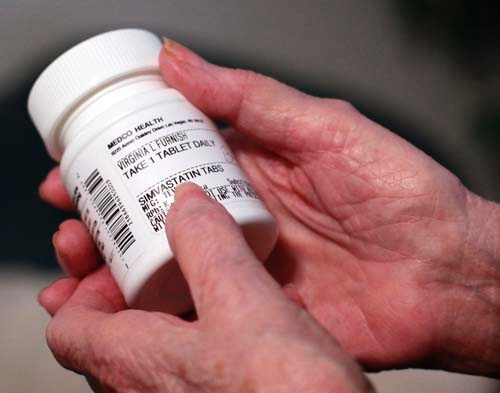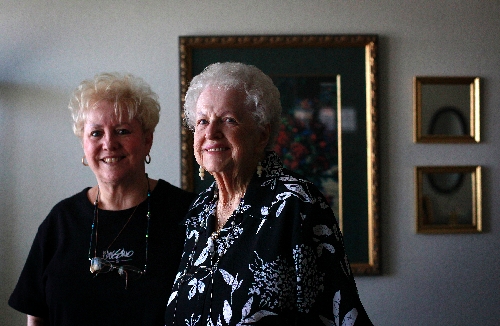Ads urge taking strokes seriously
Sharon Chaves was on the phone when the caller asked her a question that she needed some help in answering. So she asked her 87-year-old mother, Virginia Furnish, who was seated nearby.
The reply was a garbled mishmash of sound that had little resemblance to any language that Chaves had ever heard.
"I tried again with the same result," Chaves recalled last week as she sat with her mother in their home not far from Sunrise Mountain. "Her mouth was all twisted in a strange way. I could tell she was trying to talk, but couldn't. I ended that phone call real quick to see what was up with my mother."
What Chaves did then -- dialed 911 because she feared her mother was having a stroke -- isn't done often enough, according to Dr. Jeffrey Davidson, the chairman of emergency medicine for Valley Hospital, where Furnish was taken by ambulance.
"Waiting for symptoms to resolve, as far too many people do, can cost you your life or mean a terrible paralyzing disability, where you need round-the-clock care," Davidson said.
The story of what happened to Furnish last spring is now being used by Southern Nevada's Valley Health System, which consists of the Centennial Hills, Desert Springs, Spring Valley, Summerlin and Valley hospitals, in a May radio campaign designed to highlight Stroke Awareness Month.
Throughout the month, hospitals nationwide are emphasizing the signs of the medical condition that is the leading cause of disability and the third-leading causing of death in the United States.
"My name is Virginia. I can say that now," Furnish says to begin the radio spot running on local stations. "But last spring, when my daughter asked me a question, I knew what I wanted to say but I couldn't answer her."
Of all the medical misfortunes that can befall a person, none is more terrifying than a stroke.
Suddenly, you can't speak. Or your leg or arm goes numb. Half your body may become useless.
All because of an interruption of the blood supply to any part of the brain, which defines a stroke.
"It's scary," said Furnish, a great-grandmother. "You don't know what's happening to you. I thought I was talking normally, but it sure didn't sound that way."
STROKELIKE SYMPTOMS
As it turned out, doctors found that Furnish suffered what is known in medical circles as a TIA, or transient ischemic attack. It often is referred to as a mini-stroke, an episode in which a person has strokelike symptoms for up to one or two hours.
Unlike a stroke, a TIA does not cause lasting damage to the brain. But it is often considered a warning sign that a true stroke could happen in the near future if steps are not taken to prevent it.
"I started to be able to talk again while I was in the ambulance," said Furnish, who has also fought off lung cancer.
The symptoms of a TIA are the same as a stroke. They include sudden confusion; trouble speaking or understanding; sudden numbness or weakness of face, arm or leg, especially on one side of the body; sudden trouble seeing in one or both eyes; sudden trouble walking, dizziness, loss of balance or coordination; sudden severe headache with no known cause.
All too frequently, Davidson said, patients and their families do not act when the symptoms of a stroke strike. Many do not recognize the array of symptoms and simply go to bed, hoping the discomfort will subside.
What that does is negate the one major tool medical practitioners have of greatly lessening the effects of a stroke.
If given within three to 4½ hours of the first symptom, an FDA-approved clot-buster medication may reduce long-term disability for the most common type of stroke, an ischemic stroke, where a blood vessel that supplies blood to the brain is blocked by a blood clot.
CLASSIC SIGNS
Especially troubling to registered nurse Anna Smith, neuro/cardiac coordinator for Valley Hospital, is that when she holds educational programs in the Las Vegas Valley many of those on hand admit they have experienced the classic signs of stroke.
What they have probably experienced is a TIA, Smith said.
"People simply don't take the signs of a stroke seriously enough," she said. "They're very fortunate that they weren't experiencing a full stroke."
Still, Smith notes that 10 percent of the people who have a TIA will have a full-blown stroke within three months. Half of those strokes happen within 48 hours of a TIA.
"After they did all their tests on me, I got four different medications to help prevent me from getting a real stroke," Furnish said.
Smith said she hopes that people hearing Furnish's radio spot will overcome the temptation to ride the symptoms out. Most wait hours, many even days, before seeking help. As result, large numbers never recover.
That only makes the statistics spawned from stroke seem even more devastating.
EVERY 40 SECONDS
Each year, about 795,000 Americans suffer a stroke, with 160,000 dying. About 600,000 are first attacks, with the remainder recurrent attacks. On average, every 40 seconds someone in the United States has a stroke.
Strokes can -- and do -- occur at any age. About one quarter of strokes occur in people under the age of 65. High blood pressure is the most important risk factor for stroke.
About 50 percent to 70 percent of persons who suffer a stroke regain functional independence, while 15 percent to 30 percent remain permanently disabled.
The National Stroke Association estimates strokes cost the U.S. economy $43 billion a year.
Though medical professionals say the faster stroke patients get to a hospital the better their outcomes will be, Smith concedes that not all stroke victims can be helped through clot busters.
About one in six stroke patients suffer a hemorrhagic stroke, bleeding into the brain. For that, physicians try surgical means to limit the damage.
"Some strokes are so severe that people succumb," Smith said. "And some are so large that a severe brain deficit is unavoidable. But we can help so many that currently aren't being helped, that end up dead or severely disabled because they ignore symptoms."
Smith said prevention is even more critical than after-stroke protocols.
What that translates to includes: follow a healthy, low-fat diet; drink alcohol in moderation; exercise regularly; get blood pressure checked regularly and take medication to keep it in check if necessary; have cholesterol checked and take medication if bad cholesterol is too high.
"Obviously, it's better not to have a stroke at all," Smith said.
Furnish, who retired from the Star Attractions talent agency in town, has suffered no ill effects from her mini-stroke. She enjoys being the talent on a public service announcement.
"If I can convince people how to act to save lives, that would make me happy," she said. "I'm just glad my daughter knew what to do."
Contact reporter Paul Harasim at pharasim@reviewjournal.com or 702-387-2908.





























